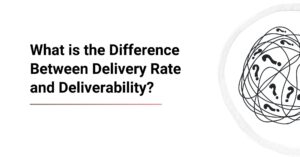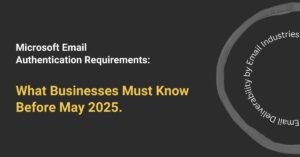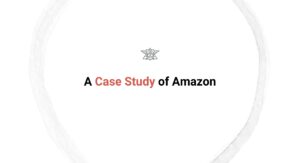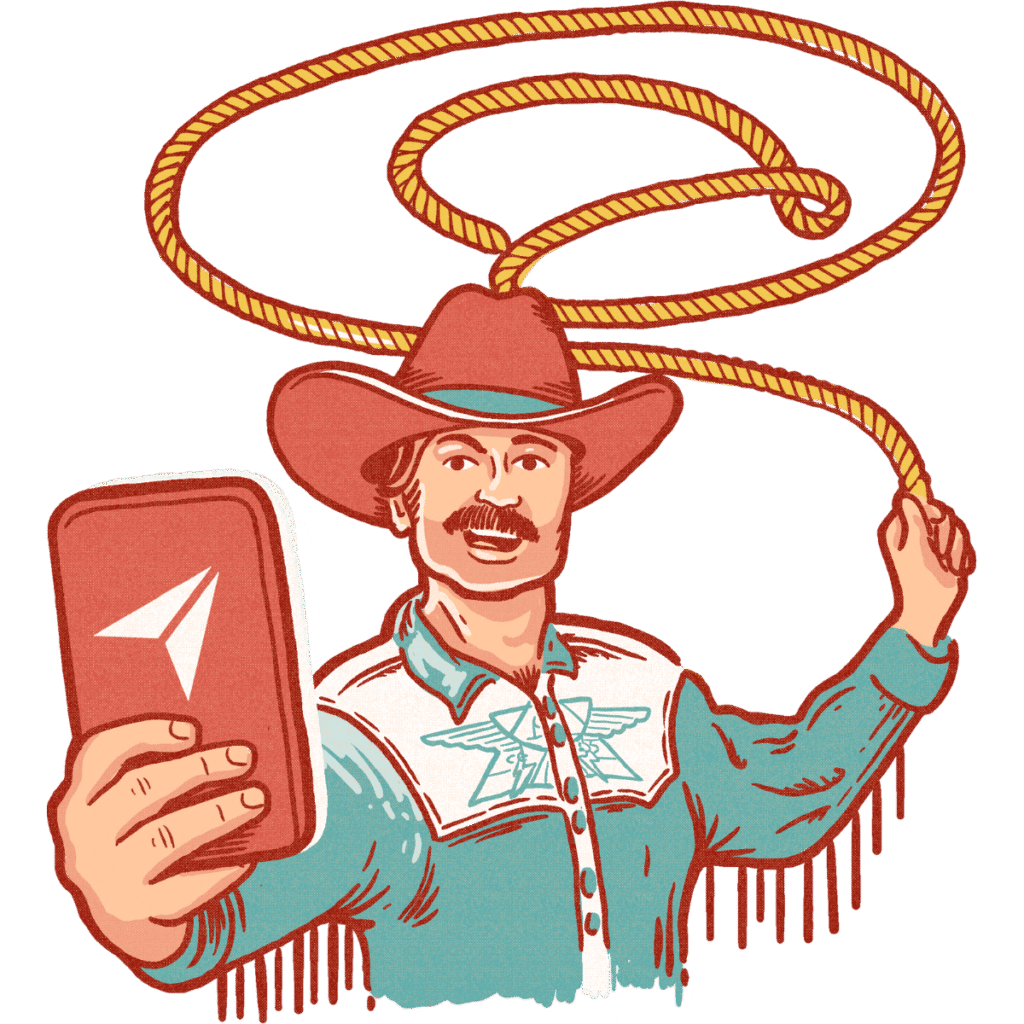Is there a best time for email marketing?
You may be surprised to learn that a minor detail, such as when subscribers receive your email, determines the success rate of your email marketing campaigns. Since 23% of all emails are read within an hour, deciding the best time to send email newsletters is crucial to campaign performance. After all, you don’t want your marketing emails to languish in recipients’ inboxes.
Sending emails at the optimal time influences performance metrics like open rates, conversion rates, and click-through rates. These email metrics help track the performance of your email marketing strategy. So, how do you identify the best time to send email messages so the audience reads your offers?
In this article, we explore the impact of email timing on campaign performance, explain how to identify the right day of the week and the perfect timing for maximizing audience interactions and demonstrate proven strategies for skyrocketing the performance of your email campaigns.
What is the Best Time to Send Emails?
Marketing emails come in various sizes and shapes. The best time to send an email depends on the type of correspondence. For example, abandoned cart emails are sent a few hours after a customer has left the website, survey emails are sent after a purchase, and invitation emails are sent a few weeks before an event. Hence, the timing depends on the type of email campaign you want to launch.
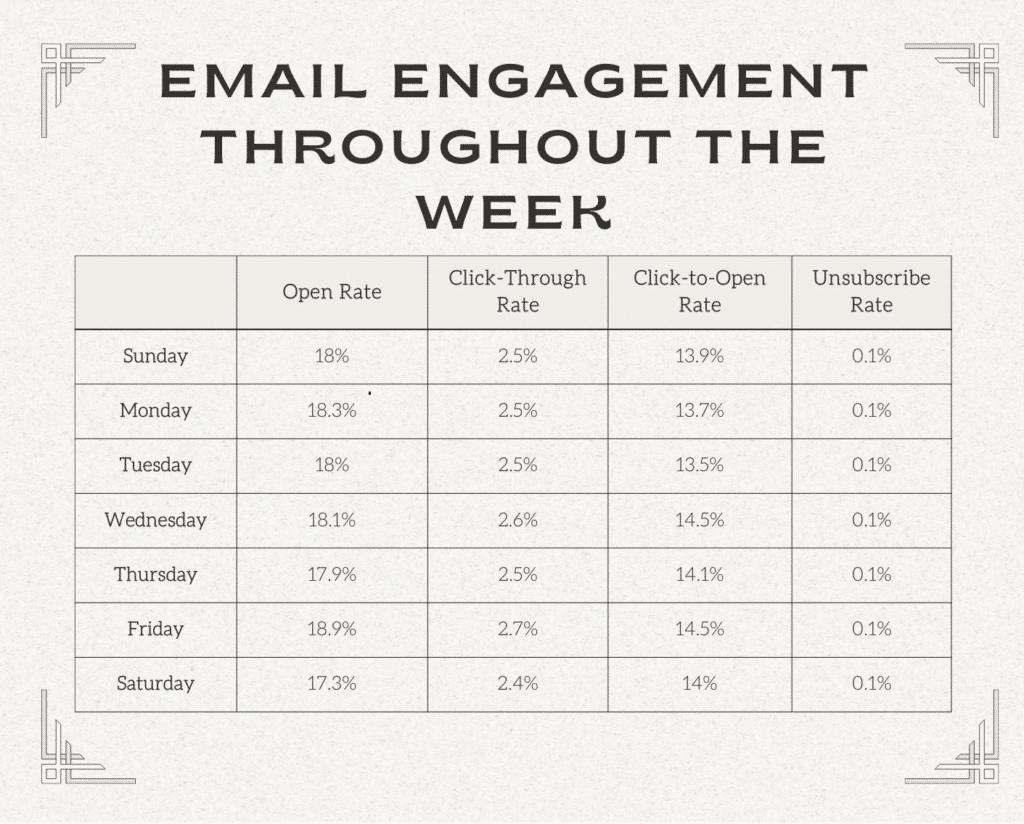
Here is a brief overview of the exact time to send emails according to the campaign type:
Email Newsletters
If your target audience is US-based, here are three things to remember:
- People read newsletters before bed. So, you should send email newsletters during the day or late in the evening.
- Thursdays and Saturdays have the lowest open rates.
- The best time to send marketing emails is between 3 a.m. and 7 a.m. and 6 p.m. and 11.30 p.m. on Mondays, Wednesdays, and Fridays.
Pro Tip: The best time to send an email on Monday is between 10.30 p.m. and 11.30 p.m. and 3 a.m. and 6 a.m. The best time to send an email on Friday is between 3.30 a.m. and 5 a.m.
Bulk Emails
The peak time for sending bulk emails is between 10 a.m. and 12 p.m. when people feel the urge to take a break between work hours and check their inboxes. The second window is between 2 p.m. and 6 p.m. A/B testing will help you find the best time of the day to send marketing emails. Test different combinations to find what works for your specific audience.
Promotional Emails
If your email subscribers are US-based, the best time to send promotional emails is 11 a.m. on a Friday. However, test multiple slots to identify what your audience prefers. You can adjust the delivery time during the holidays and personalize subject lines, offers, and content for greater conversions.
Transactional Emails
There are several kinds of transactional emails, such as order confirmations, abandoned cart reminders, and thank-you emails. The best time to send a transaction email depends on the situation.
For example, you should send the first abandoned cart reminder a few hours after the customer leaves your store. Send the second reminder 24 hours later to remind them of the incomplete purchase. Send the third email a week later with a discount to lure them in.
Welcome Emails
Welcome emails have the highest open rates and can turn customers into loyal patrons. Research shows that a three-part welcome email series most effectively converts prospects into paying customers.
Here is a tested three-part email series for maximum engagement. You can customize the content according to different industries.
- Send the first email right after someone subscribes to your email list or newsletter.
- Lead subscribers down the sales funnel with a second email promoting your products or offering a discount.
- Send the final email 48 hours after the first email. By now, most prospects will have already decided to move forward with the purchase. Your email nudges them to take action immediately.
Pro Tip: Tech startups and payment processors may require more than three emails to convey the message effectively without omitting crucial information. Therefore, finding the ideal number of welcome emails is entirely at your discretion. Follow the instructions above and test your email campaigns thoroughly to identify what works best for your industry.
Follow-up Emails
Follow-up emails are the most time-sensitive and can yield excellent results. However, less than 3% of businesses follow up with potential customers. Here are four follow-up email tips to maximize customer engagement and retention rates.
- If a customer contacts you, respond immediately. If it’s the other way around, send a follow-up email after 3 days.
- Refrain from following up on Mondays and Fridays.
- Tuesday is the best day of the week for following up, followed by Wednesday. 10 a.m. is the prime time since people are most productive at this hour and tend to pay more attention to business emails.
- You can send emails at 10 p.m. on Saturday and 8 p.m. on Sunday to entrepreneurs and people who plan their weekly schedules in advance.
Cold Emails
Recipients are more likely to read cold emails if they appear at the top of their inbox. Send emails between 6 a.m. and 9 a.m. on business days to maximize open rates.
B2B Emails
B2B emails are most effective in the middle of the week, when people are in full work mode. You can send emails on Tuesday, Wednesday, or Thursday between 5 a.m. and 7 a.m. However, research your recipient’s local time zone and identify the optimal time to maximize the potential of your marketing campaigns.
B2C Emails
B2C emails are most effective when the recipients are active. According to research, the best delivery time are Monday and Friday at 9.30 p.m. This is right after working hours when people browse emails actively and visit an online store.
Tips for Optimizing Your Email Schedule
We all perceive marketing emails differently. Experienced email marketers know the importance of A/B testing minute elements to optimize the potential of marketing efforts. Here are four factors that determine the efficacy of your marketing email:
Know Your Audience
Before you can create emails that convert, you must understand the customer’s wants, needs, and expectations. Here are four questions experienced email marketers ask to identify the target audience:
- What is the recipient’s local time zone?
- What type of content does the recipient prefer?
- Are they smartphone or desktop users?
- What are the peak engagement times on my website and social media?
You can even launch an email survey asking subscribers when they want your weekly newsletters. Utilize all the data to optimize your newsletter timing.
Test Different Send Times
A/B testing is the only way to identify the best email schedule. Send the same email to different subscriber lists at different times to identify the best time of the day for sending emails.
Be Consistent
Once you find the ideal time for sending newsletters, stay consistent. Your subscribers might look forward to reading your midweek emails. It’s crucial to deliver relevant content consistently to build brand awareness and strengthen customer relationships.
Monitor Performance
Sending newsletters on a specific date is insufficient for maintaining high open rates or click-through rates. Therefore, you must regularly track performance analytics to identify seasonal trends and update your marketing goals.
How to Find the Best Time of Day to Send Marketing Emails
You can track the performance of marketing campaigns and adjust your strategies accordingly to find the best time for sending marketing emails. Here are four metrics to optimize your email habits:
Open Rates
Open rates measure the number of people who opened an email. This crucial metric helps identify send times and other factors affecting email engagement. To improve open rates, you can optimize subject lines, delivery time, sender reputation, and deliverability score.
Click-through Rates
The click-through rate measures how many people who received your email clicked on at least one link. This helps measure the efficacy of your content in persuading readers to take action. You can optimize the body copy, visual elements, CTAs, and offers to improve click-through rates.
Unsubscribe Rates
Not everybody in your subscriber list is interested in the same offer. While some want to receive product recommendations, others might only be interested in offers and discounts. Hence, sending the wrong message at the wrong time to the wrong people will result in unsubscribes. You can segment subscribers and send personal emails to reduce unsubscribe rates.
Bounce Rates
Bounce rates increase if your emails land in the recipient’s spam folder instead of their inbox. This indicates that you need to improve email deliverability.
Identify the Perfect Time to Send Emails and Increase Conversions with Expert Guidance
Sending emails at the right time is crucial for email marketing success. However, there is no one-size-fits-all solution here. Therefore, you must consistently test various variables to identify a suitable email schedule for your business. Use the above-mentioned marketing metrics to track and measure performance and adjust your marketing strategy to increase customer engagement, conversion, and sales.
Our marketing experts can help improve your email campaigns to generate leads, turn prospects into paying customers, and convert one-time buyers into loyal patrons. Click here to book a discovery call now!

